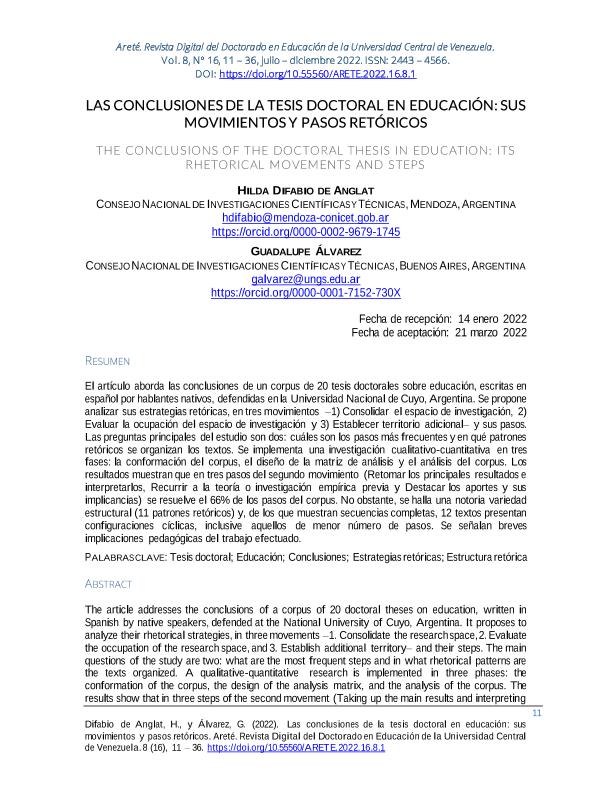Artículo
El artículo aborda las conclusiones de un corpus de 20 tesis doctorales sobre educación, escritas en español por hablantes nativos, defendidas en la Universidad Nacional de Cuyo, Argentina. Se propone analizar sus estrategias retóricas, en tres movimientos –1) Consolidar el espacio de investigación, 2) Evaluar la ocupación del espacio de investigación y 3) Establecer territorio adicional– y sus pasos. Las preguntas principales del estudio son dos: cuáles son los pasos más frecuentes y en qué patrones retóricos se organizan los textos. Se implementa una investigación cualitativo-cuantitativa en tres fases: la conformación del corpus, el diseño de la matriz de análisis y el análisis del corpus. Los resultados muestran que en tres pasos del segundo movimiento (Retomar los principales resultados e interpretarlos, Recurrir a la teoría o investigación empírica previa y Destacar los aportes y sus implicancias) se resuelve el 66% de los pasos del corpus. No obstante, se halla una notoria variedad estructural (11 patrones retóricos) y, de los que muestran secuencias completas, 12 textos presentan configuraciones cíclicas, inclusive aquellos de menor número de pasos. Se señalan breves implicaciones pedagógicas del trabajo efectuado. The article addresses the conclusions of a corpus of 20 doctoral theses on education, written in Spanish by native speakers, defended at the National University of Cuyo, Argentina. It proposes to analyze their rhetorical strategies, in three movements –1. Consolidate the research space, 2. Evaluate the occupation of the research space, and 3. Establish additional territory– and their steps. The main questions of the study are two: what are the most frequent steps and in what rhetorical patterns are the texts organized. A qualitative-quantitative research is implemented in three phases: the conformation of the corpus, the design of the analysis matrix, and the analysis of the corpus. The results show that in three steps of the second movement (Taking up the main results and interpreting them, Resorting to theory or previous empirical research and Highlighting the contributions and their implications) 66% of the steps of the corpus are resolved. However, there is a notorious structural variety (11 rhetorical patterns) and, of those that show complete sequences, 12 texts present cyclical configurations, including those with fewer steps. Brief pedagogical implications of the work carried out are reported.
Las conclusiones de la tesis doctoral en educación: Sus movimientos y pasos retóricos
Título:
The conclusions of the doctoral thesis in education: Its rhetorical movements and steps
Fecha de publicación:
03/2022
Editorial:
Universidad Central de Venezuela. Doctorado en Educación
Revista:
Areté
ISSN:
2443-4566
Idioma:
Español
Tipo de recurso:
Artículo publicado
Clasificación temática:
Resumen
Palabras clave:
TESIS DOCTORAL
,
EDUCACIÓN
,
CONCLUSIONES
,
ESTRATEGIAS RETÓRICAS
Archivos asociados
Licencia
Identificadores
Colecciones
Articulos(SEDE CENTRAL)
Articulos de SEDE CENTRAL
Articulos de SEDE CENTRAL
Citación
Difabio, Hilda Emilia; Alvarez, Guadalupe; Las conclusiones de la tesis doctoral en educación: Sus movimientos y pasos retóricos; Universidad Central de Venezuela. Doctorado en Educación; Areté; 8; 16; 3-2022; 11-36
Compartir




